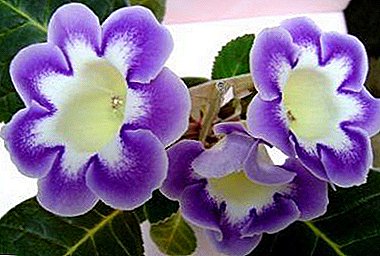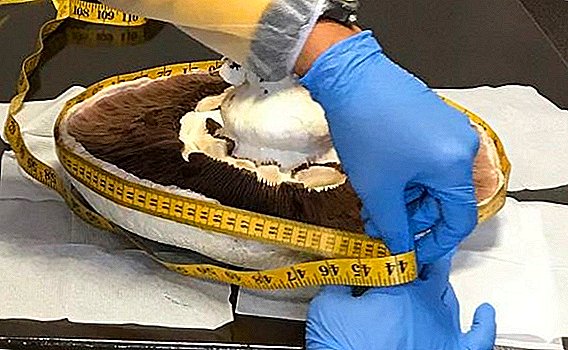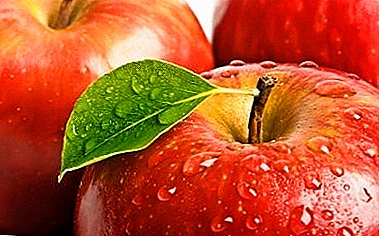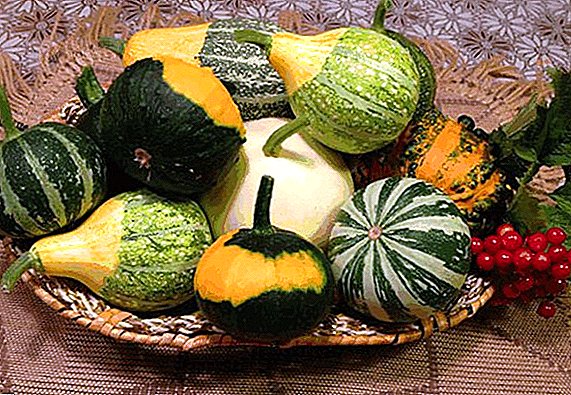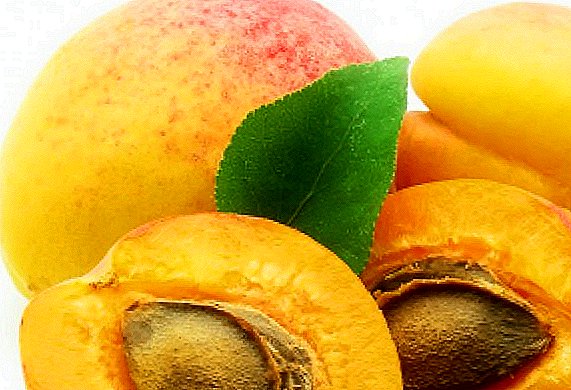
For the successful growth and fruiting of fruit trees in the garden, they must be grown by caring for and caring for them. One of the most important stages of such care is pruning garden trees. This rule does not bypass the apricot tree, which is very light-requiring and has thick branched, but at the same time very flexible branches.
So that the crown of the tree does not grow, and it began to bear fruit as quickly as possible, the sapling is carried out annual pruning of the branches. Pruning produce and already adult tree. This process is carried out with the aim of rejuvenating the tree and preventing the thickening of its branches. How correctly, and when to do this, we describe below.
About Apricot Trimming Scheme

Let's look at the species that exists, which are divided into formative pruning, regulating, rejuvenating, restorative and sanitary. Thus, a young tree is subjected to formative pruning, which allows it to give a certain shape to its crown, to stimulate the activity of increasing the volume of branches and to get an earlier fruiting of the tree.
The main task of the regulatory pruning is to maintain the yield in the amount achieved and prevent the growth of the tree from weakening.
Rejuvenating pruning is done to enhance the growth of branches, to stimulate the appearance of young, more prone to fruiting, rationing the load of the crop, and preventing deterioration in the quality of fruits.
Restorative pruning is mainly used when there is mechanical damage and freezing of the tree.
All kinds of pruningAs a rule, do not apply alone, but combine with each other.

One of the goals of cutting apricot branches is the formation of its crown, as well as the formation of new shoots every year. Both the one and the other pruning are produced according to a certain scheme, which you definitely need to know.
Crown apricot tree in most cases cropped by sparse method . But there are several other methods of forming the crown of the tree. This is a method called an improved bowl system with a single-level single branch placement, and the formation of a tree in an area that is limited, this is the so-called method of flattening the crown.
Formation of the crown of the tree by the method of sparse-tiered pruning is done by growing 5-7 first-order branches with an interval of 35-40 cm between them. The method of flattening the crown is used if it is necessary to obtain early fruiting of the tree, as well as high-quality harvest.
To form the apricot crown begin with cutting branches located at 0.9 m from the ground. First, two branches are cut in half, located along the main row. Then the rest is cut off on the ring, while leaving only the main conductor 20-25 cm above the main branches. In the summer, they cut out branches growing at an acute angle, and branches that are not the main ones.
The following year, the laying of the main branches continues, starting at 35-45 cm, to form the second order of branching, while not forgetting the order of subordination of the branches with the central conductor. Unnecessary branches growing on the trunk turn into overgrowing ones shortening them, while strong one-year branches 60 cm long cut to half length, and even more, and overgrown and small do not cut off at all. The main conductor is cut above the branch that grows last.
The yielding apricot is cut to lighten the tree, while removing the branches that grow inside the plant and thicken it. Pruning is also carried out to stimulate the growth of strong shoots, which later mainly form fruits, and to prevent crop overload and alopecia of its branches.
There is still a rejuvenating pruning of fruit trees, which is carried out in case of suspension of the growth of the shoots of the plant.
This type of pruning is based on the excellent ability of the apricot to recover. Pruning is carried out under the condition that the shoots of the annuals of the tree have grown up to 30 cm in length. This procedure is carried out by transferring the lateral branches to the zone of strong shoot growth.
Crop apricot in autumn

Apricot tree is different from other fruit trees in that his ovary is not shed independently, and from most of its inflorescences the fruits ripen. This feature of this fruit tree leads to severe overloading of fruits, and this leads to depletion of the culture and breaking off its branches.
Therefore, in order to preserve the normal and balanced state of the fruits, leaves and branches of the tree, it should be carried out its autumn pruning. In the fall produce a forming, regulating and rejuvenating pruning.
What is the timeline for pruning?
Autumn pruning of the apricot tree is held in October, and more precisely in its middle. At the same time, not all varieties of apricot are pruned in autumn, but only the early and middle varieties of this crop.
Restoration of growth in a tree is carried out by very strong cutting of perennial wood. Namely, in the second and third years after planting the tree, the third part of the fruit branches is removed, using a rarefied-tier system of forming 5-6 branches of the plant skeleton. At this time, professional gardeners also recommend pinching the main branches, which appeared 12-15 leaves.
The sprouting long fruit branches are shortened to 50 cm. At the same time, all cuts on the tree are made with a saw, a very sharp knife, or a shears, while doing this carefully, so as not to touch the wood. It is very important to process all sections after circumcision with a previously prepared garden pitch.
Autumn pruning apricots

Early spring spend forming, sanitary, as well as anti-aging pruning apricot tree. The apricot is put in the shape of a crown as desired, forming a bowl, a palmette or a shrub. In this case, I use a sparse-tiered trim system.
In spring, the fruit tree is pruned for the first time. Cuts are made on a kidneywhich is located on the side that is opposite to the grafting site. This is done to preserve the vertical growth of the central trunk.
The task of the main post-plant circumcision is to correct the shortcomings that exist in the structure of the young crown, determine the location, quantity, and the force with which the main branches grow, ensuring the conductor a leading position.
On the timing of pruning in the spring
Spring pruning of apricot is carried out after the temperature rises, until the first leaves appear.
The first pruning of a tree after planting is carried out at an annual age of at least three to four weeks by the beginning of the growing season.
If two summer plants were used for laying the garden, the first pruning is also made in early spring, a year after planting. During this time, the branches will not give strong gains, and the trees that have not been cut, due to the growth of leaves in a larger area, will develop a strong rhizome.
Sanitary pruning and crown cleaning dry, improperly growing, thickening branches can be produced at all stages of tree development at any time.
Pruning apricot tree in summer

In the summer, apricot fruit trees are rejuvenated pruned. Summer pruning of apricot contributes to the formation of a huge number of new branches and fouling of the bare parts of the semi-skeletal and skeletal branches.
Early summer pruning provides a strong growth to the tree, the plant has time to restore its liliness, and to lay fruitful buds on the secondary shoots. In late summer pruning, the second wave of growth does not occur, and the tree does not plant flower buds, while its leaf cover decreases. It is worth noting that the wounds inflicted in the summer, heal well.
The timing of summer trim
Pruningwhich rejuvenates wood produced in early June. At the same time, a year after such pruning, fruiting increases, fruits become larger and more qualitative, and the incidence of wood decreases. The results of pruning in the summer can be happy for three years. Therefore, it is carried out for three years once.
It is very important to remember that if the tree lacks moisture or there is not enough intake of nutrients, pruning in June is not worth it, this can significantly worsen the condition of the plant.
What tools to use

When planning a garden, a novice gardener should definitely acquire the necessary equipment.
Namely, for the care of fruit trees and not only, are needed:
- air or hand pruner
- garden, copulating and inoculum grafting knives
- garden file
- triangular file
- special paste
- straightening belt and cutting point
- whetstone and bar
- twine for securing the branches
- for stripping wounds chisel
- means for their closing (garden var, paint)
Preparing tools for work
First of all, the whole the tool must be very carefully sharpened. Sharpening garden, okulirovochny and kopulirovochny knife to start removing chamfer. In such knives, as a rule, it is located on one side. It is grinded until it appears from the sting of the blade to the butt, an even wedge without bends and blockages.
After this, the knife sharpening is continued on a fine-grained bar. To this end, the knife blade, where the chamfer was located, is pressed against a bar or a log over the entire surface, while simultaneously moving it forward and upward, starting from the upper edge of the blade to the lower forward edge. On the other hand, in order to avoid blockages, at this time, slightly correct the blade sting.
After that, the knife is ruled by a whetstone During sharpening, the bar and wheel are wetted with plenty of water. This is done to remove sawdust from iron and carborundum and graphite masses.
The grafting knife is also additionally corrected on a belt that has been previously lubricated with a special paste. If the sharpness of the tool is similar to the sharpness of a razor, it is ready for operation. If the garden knife is not blunted, it is ruled on the little wheel, right when he is at work, and the inoculation knives rule additionally on the belt.

Very blunted or new pruning shears disassembled. At the same time in the sequence and according to the rules for sharpening the blade, as for garden knives. Once assembled, the tool checks how it then works.
A well-established pruner has only two points that adjoin the blade to the shear plate: near the articulation of the hinge and near the apex of the corner where the blade and the plate are opposed. If there is no such contact, it is necessary to tighten the nut, and if the secateur opens and closes tight, then release it. Sharpening and dressing pruner during operation, hold it without disassembling.
Garden saws are prepared for work, properly spreading its teeth. To this end, one tooth of the sylegon is bent to the left, the next to the right, and so on. In this case, the sharpened side of the tooth should be inside. The bending angle is maintained equally to all teeth.
In order to avoid mistakes, the saw is raised from time to time to eye level, and they look to see if the teeth are out of the row. And if necessary, immediately corrected. If the wiring is done correctly, the rows of teeth are clearly visible, with the saddle visible between them.
At the top of the teeth, the saw should be one and a half times larger than the thickness of its blade. If it suddenly turns out to be less, the file will jam, and if it is more, the cut will be uneven. The teeth are sharpened with a file only along the edge from the side located inside.
Tool care plays an important role
It is impossible that during operation the tool is very stupid. Having finished work, from all tool clear dirt and wipe it dry. If you do not plan to use the tool for a long time, in order to prevent rust, it is necessary to lubricate all its parts from metal.
The spring at the secateurs is removed, it is stored separately. If rust still appears on the instrument during storage, it must be cleaned thoroughly and lubricated again.
What are the features of apricot pruning?

Taking into account some regularities of trimming, it is possible to achieve the effectiveness of the expected result. Thus, pruning is most effective only if:
- it is aimed at a specific goal and solves certain tasks;
- if it is carried out according to the laws of growth and fertility of the tree;
- if it is performed, taking into account the possibility of a reaction to a particular reception of the tree of a given species, age and condition;
- if during pruning they use only those techniques that, in a particular situation, with the slightest disturbance of the normal state of the plant, bring us closer to the solution of the problem;
- if pruning is done in the best possible time;
- if pruning is carried out at the highest agrotechnical level along with other activities related to the care of wood and soil;
- if you are pruning, you have hands-on experience with wood and tools.
During pruning, it is also very important to take into account the patterns of growth and fruiting of the apricot tree. Note that nf all buds in spring are taken to grow. Some of them do not awaken.
The ratio of those buds that bloomed to the number that did not bloom, but which were laid on the one-year strong branch, determines the susceptibility of the kidneys. The less awakeness, the more the trees are arranged to form long, bare, ankle branches.

Of the buds that have awakened, formed leafy rosettes and shoots of different length and purpose. The number of long branches of the vegetative type shows the educational capacity of the tree. The greater the succession of a tree, the more it thickens with time.
Proceeding from this, during pruning, one should remember about the potential (varietal) and real (at a given growth period, the state of the plants) the budding of the buds and pooregoobrazovatelnuyu ability to prevent thickening of the crown instead of its rarefaction, and, conversely, not rarefied and so rare crown.
When determining the ability to spawn, the strong shoots that appear in the middle of the drooping, arcuate, those that grow old, have mechanical damage or freeze, are not taken into account.
Plants have the ability to grow stronger branches by alternating branched and not very branched shoots. This morphological feature of the crown structure is called tiered and is taken into account during the formation and pruning of the tree.
In addition to the described features of the branch of the tree, it is also important do not forget about the direction and strength of the growth of branchesbecause it affects the crown, its overall size, as well as the placement of fruit and vegetative formations.
Give longevity to your favorite tree, following all the recommendations given. And care and care, except for pleasure and enjoyment, will also bring a guaranteed good harvest.






